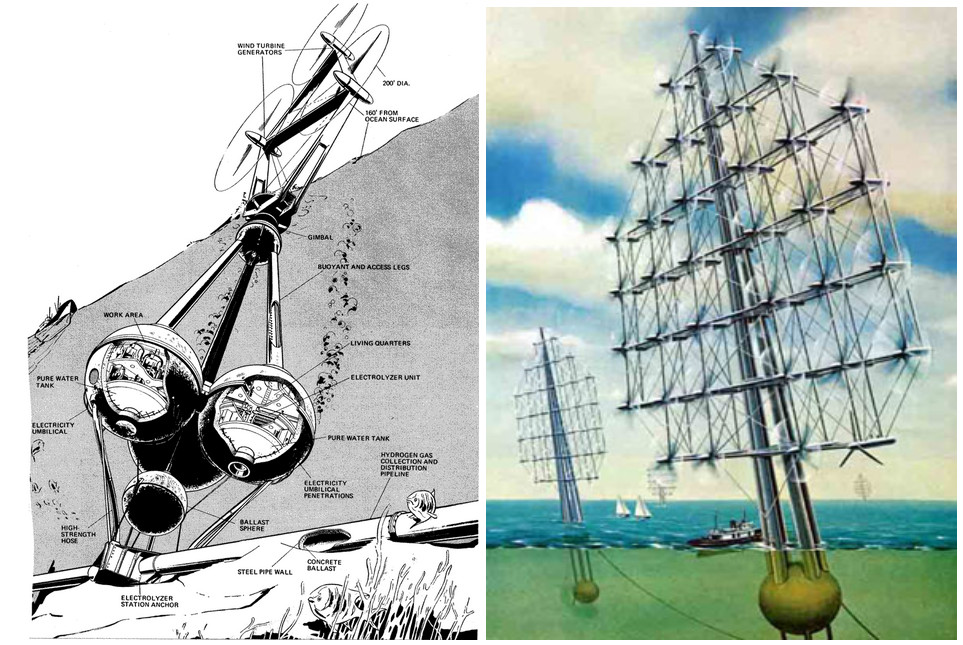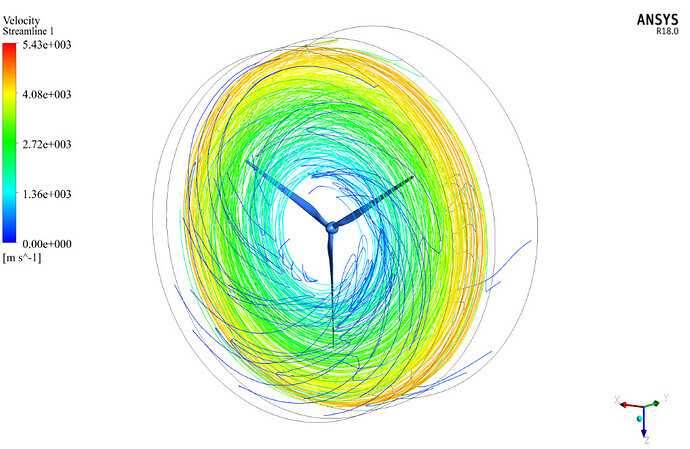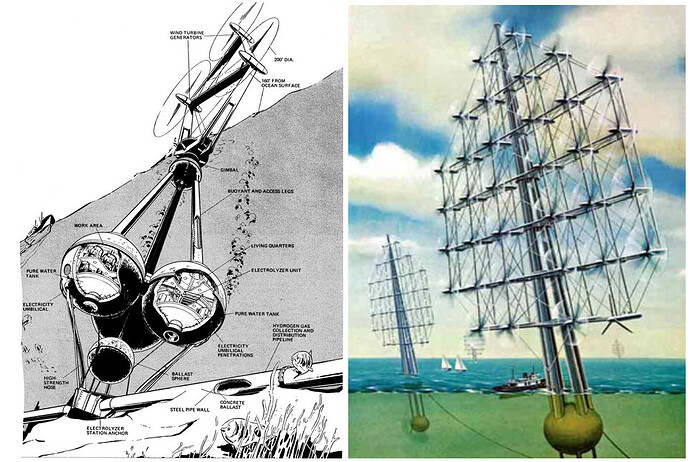OK I am putting this in “news” because it is “news” that people are “talking” about this concept again.
LINKS:
https://windcatching.com/technology
Heronemus, the “father of wind energy” invented this general concept. He called it “Windship”. It’s basically a wall of wind turbines, mounted on floats. (Heronemus’ first patent references my first wind energy patent as prior art.)
Another “press-release breakthrough”. Will it ever be built? I don’t see any reason why not, except the history of such structures entails problems with structural oscillations. One big red flag though is the name: “Windcatch” and various versions thereof (“Windcatcher”) are symptomatic of newbie-esque “talking point” turbines that are never built or never work out. But I do think it addresses the cube-square laws and the size of rotating parts, except it does not eliminate the square/cube law but merely shifts the cube-square law to the supporting structure. I wonder how long it might take to re-aim in shifting winds…
1 Like
Woooah. Is this what my tax money is paying for?
I think an immediate issue is that for a windmill it does actually impact the surrounding air some distance away from the rotor. With this concept, the turbine blades are so close that this effect is lacking and I believe and fear that it will impact performance.
[Random] Source: (HAWT) 3-Blade Horizontal Axis Wind Turbine CFD Simulation | Mr CFD
2 Likes
This is the question I am asking myself. Multirotor configuration is also studied on:
https://www.researchgate.net/publication/257712257_Multi-Rotors_A_Solution_to_20_MW_and_Beyond
On the other hand it seems that the rotors of the SuperTurbine ™ do not suffer significant aerodynamic losses if we believe the report below:
Pierre: I think the side-by-side arrangement of turbines would be fine. Looks like they were contemplating two-bladed rotors, from the photo of the models near the stairway. Regarding my own research, if you read the report carefully, you’ll see we used special certified, calibrated sensors (costs extra) and an independent third-party to run the turbine and take the data, for the purpose of making sure the data was accurate. People should realize one thing about wind energy: making the power is the easy part. Controlling it in high winds is the hard part.
When you read carefully, the following passage is where the red flags start to flash:
"the company’s goal is to complete technical testing and verification in 2021 and “offer commercial development solutions in 2022.”
The company claims one Wind Catching unit is “five times as efficient than a conventional offshore wind turbine.”"
OK so they have only a few months left to offer commercial development solutions. I guess they better get things running pretty quick, eh?
AND it’s 5 times as efficient? One would have to read between the lines and find some way such an absurd statement could be true, since a rotor is a rotor. Racking my brain, I’m coming up with maybe they mean 5 times as efficient of a use of material if you don’t include the support structure…
Weird how they don’t acknowledge that it is the oldest idea for a windfarm going back to the 1970’s. Oh well they probably don’t even know…
Even the fact that they do not use proper English, which would be “five times as efficient as” is a red flag. Funny but the more fake news you are exposed to, the more patterns you can discern. Seems like such claims that amount to being being more efficient than 100% are often stated with grammatical errors or awkward language.
Update: Maybe they mean 5 times as “powerful” as, for example, a single 14 MW turbine.
Original artwork from the 1970’s Heronemus’ “Windship” concept - all about making hydrogen at sea. Interesting to note the apparatus would capsize with all the weight up top and flotation at the bottom. And most people still haven’t gotten the memo that after electrolysis, compression, and retrieval, all very inefficient, hydrogen is about the least efficient form of energy storage known.

1 Like
From https://www.researchgate.net/publication/324565013_Innovation_in_Wind_Turbine_Design (Peter Jamieson): page 232 (“Aerodynamic Performance of Multi Rotor Arrays”):
The aerodynamic performance of a large array of closely spaced horizontal axis wind turbines (HAWTs) has not been much researched although, in an elegant wind tunnel experiment, Smulders et al. [4] showed that a pair of rotors as closely spaced laterally as 2.5% of diameter had no net loss in power performance and even a slight gain.
I do think we have progressed alot in the graphics department since the 70s though, but I have to admit the ideas look somewhat the same.
I wonder if doing a CFD with so many blades is feasible?
Something tells me that without such an in-depth micro-analysis, on a higher-level, there is a similarity to just a single larger rotor, versus a theoretical side-by-side array of smaller rotors. Lagerwey, Vestas, and others have built and run lateral arrays of turbines, usually just 3 - 5(?) and I’d be surprised if someone hasn’t done a CFD study of some type.
Sure you might find relevant papers to extrapolate from. But this seems novel enough to warrant its own simulation. What happens in the center and middle of the rig? What is the best induction factor for each blade? Which direction should they rotate?
You get all these answers for free with CFD, better than any extrapolation. If you can set up a single blade, its quite straightforward to simulate a 16x16 matrix or whatever. But computational resources may be important just due to the sheer volume of the interesting air. If one sim takes one year, results are still far away
I’d guess such a simulation could be done easily using existing models. Maybe it could be done in one day or less. I do think people get distracted by such trendy-sounding busy-work. Maybe some “Professor Crackpot” could get a bunch of interns to spend a year looking at 3-printing the blades or something. At some point it is good to build and run any such idea at some scale. What could be more simple than just trying it. Get a few small turbines, put them on a frame, fire it up, and see what happens. Already been done, the data is out there. This is such an ancient idea I’d be surprised if some CFD studies haven’t already been done. If not, it would make one more “great” paralysis-by-analysis diversionary delay tactic to never build anything and just endlessly hypothecate and try to get funding for more sitting around at the computer.
Vestas surely has tested the efficiency of these multi-rotor devices.
Beside that, close to each other Makani turbines did not seem to have been a problem.
But it may be that the structure is very heavy while some mass is gained on the small rotors. And the whole structure must turn when wind direction changes.
Perhaps an arrangement of the turbines in a circle like this can also improve the density, harnessing a whole wind frontal airspace like multi-rotor frames intend to do, but without such heavy structures.
So what WAS the problem(s) with Makani? After reading the intimidating level of hype and promises for years on end, hearing of all the “talent” they had supposedly hired and applied, all the “knowledge”, “skill”, “expertise” money could buy, including simulations, CFD, etc., then to see it, in the end laboriously trying to even just complete a circle in the air - whooaaah.
I am on the one hand, completely blown away at the sometimes amazing level of knowledge and skill in science and engineering, but also amazed at how badly it can be screwed up. That was like a Wizard of Oz moment when you finally realize it was all a big show, and there is just some little guy behind the curtain who maybe never even have any answers at all.
I still don’t think they disproved the entire space or concept, just that their implementation and exact details were wrong.
1 Like
I assume that Windcatcher uses a generator at each turbine which must account for most of the weight. Why not connect all the turbines with pulleys and belt drives? In this way we can reduce system weight and also use different pulley sizes to increase generator speed and efficiency.
1 Like
Everything else: too much mass, too much slowing down uphill, too many crashes …
1 Like
I think the whole structure is still far heavier than numerous relatively small generators.



